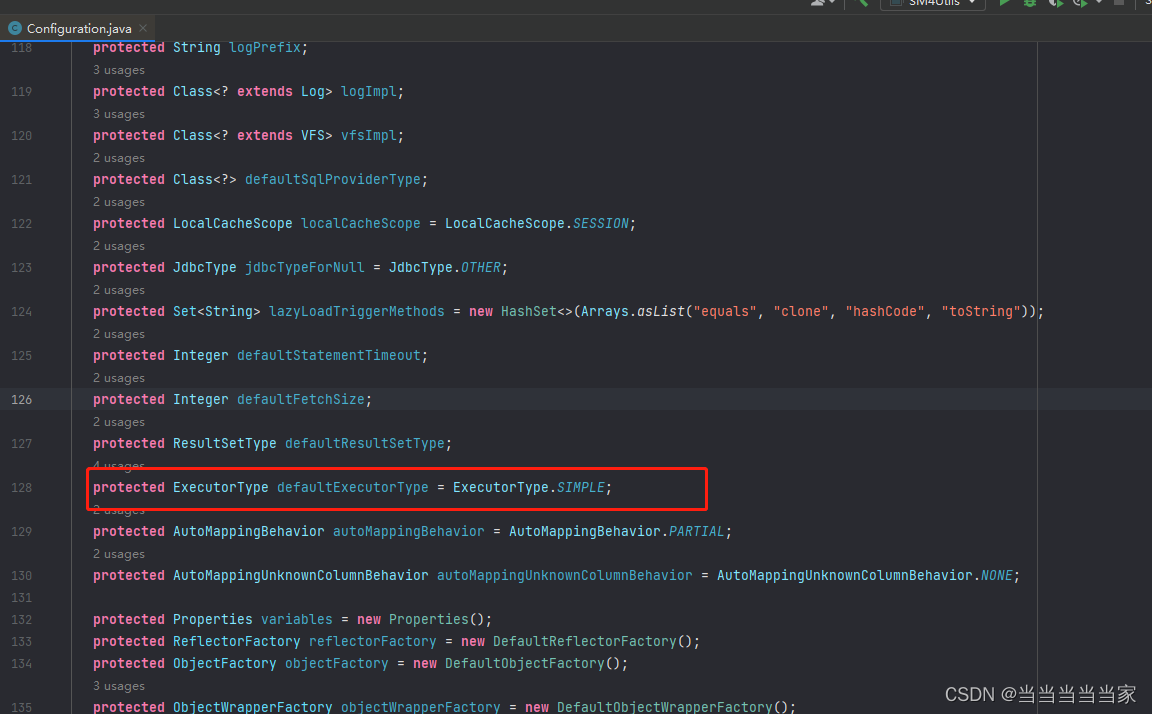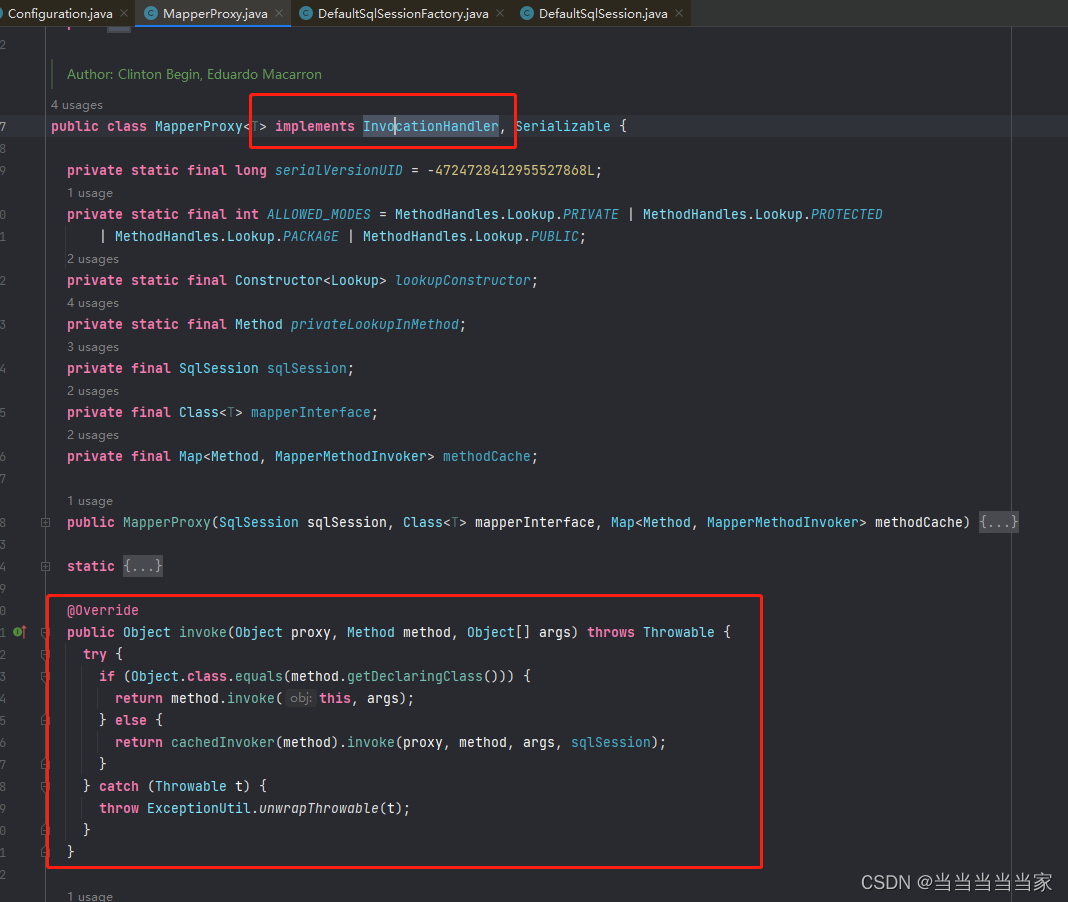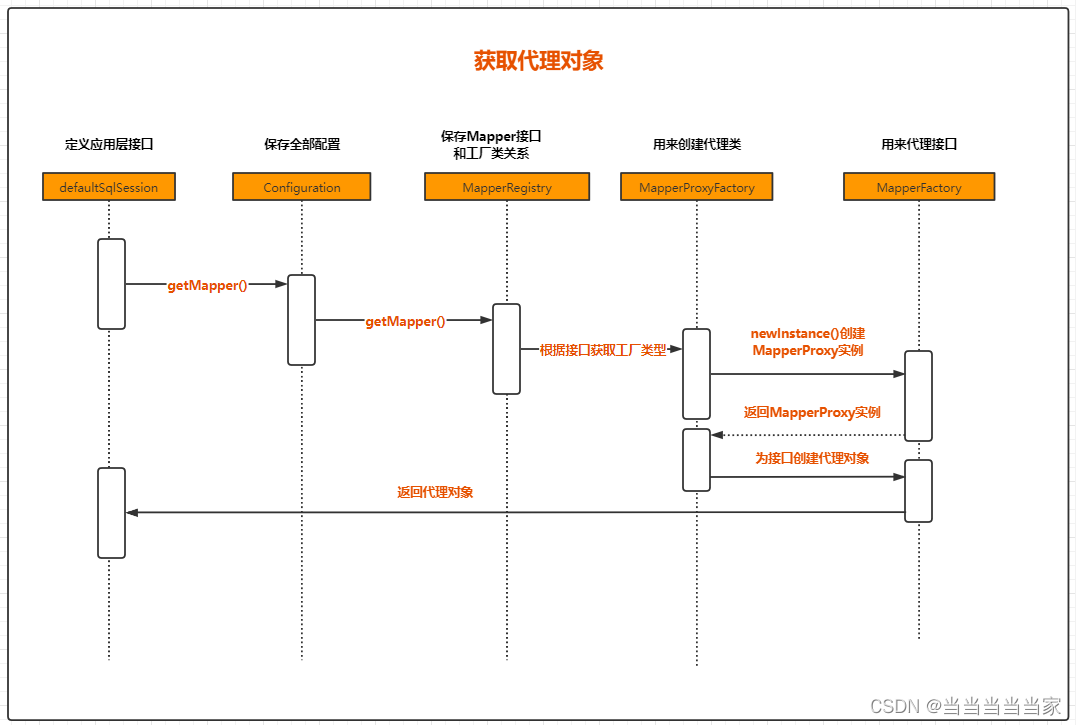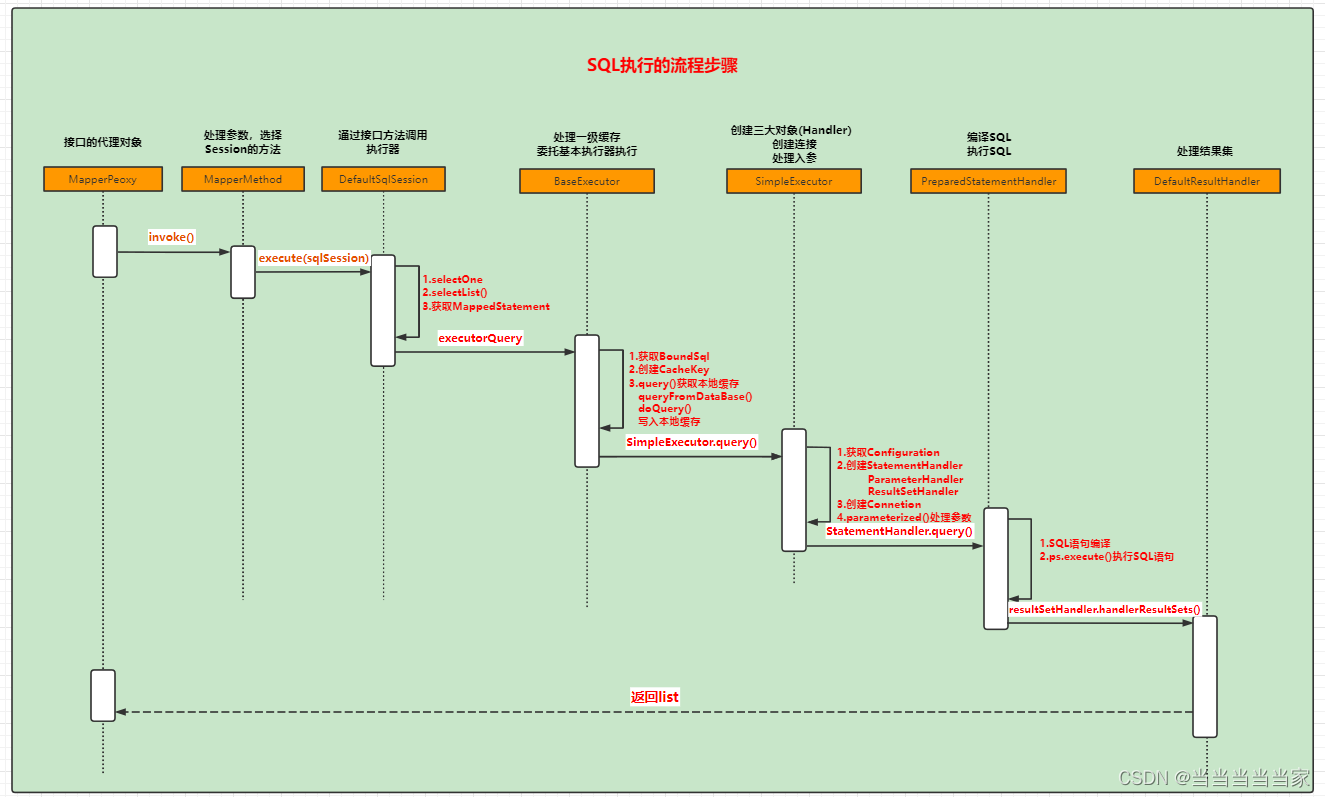前言
沿着上篇文章,咱们继续分析,没看过的小伙伴可以点下面链接去看看。Mybatis 源码分析(一)![]() https://blog.csdn.net/cfa3288/article/details/127240553?spm=1001.2014.3001.5501
https://blog.csdn.net/cfa3288/article/details/127240553?spm=1001.2014.3001.5501
SqlSession
程序每一次操作数据库,都需要创建一个会话,我们用OpenSession()方法来创建。接下来看看SqlSession创建过程中做了哪些操作
SqlSession sqlSession = factory.openSession();
通过前面创建的DefaultSqlSessionFactory的openSession方法来创建 ,默认获取的simple执行器。
@Override
public SqlSession openSession() {
return openSessionFromDataSource(configuration.getDefaultExecutorType(), null, false);
}
继续往下看。..
在解析environment标签的时候会创建TransactionFactory对象,根据事务工厂和默认的执行器类型,创建执行器。最后返回的是一个DefaultSqlSession对象,在这个DefaultSqlSession对象中包括了Configuration和Executor对象
private SqlSession openSessionFromDataSource(ExecutorType execType, TransactionIsolationLevel level, boolean autoCommit) {
Transaction tx = null;
try {
final Environment environment = configuration.getEnvironment();
// 获取事务工厂
final TransactionFactory transactionFactory = getTransactionFactoryFromEnvironment(environment);
// 创建事务
tx = transactionFactory.newTransaction(environment.getDataSource(), level, autoCommit);
// 根据事务工厂和默认的执行器类型,创建执行器
final Executor executor = configuration.newExecutor(tx, execType);
return new DefaultSqlSession(configuration, executor, autoCommit);
} catch (Exception e) {
closeTransaction(tx); // may have fetched a connection so lets call close()
throw ExceptionFactory.wrapException("Error opening session. Cause: " + e, e);
} finally {
ErrorContext.instance().reset();
}
}
public Executor newExecutor(Transaction transaction, ExecutorType executorType) {
executorType = executorType == null ? defaultExecutorType : executorType;
executorType = executorType == null ? ExecutorType.SIMPLE : executorType;
Executor executor;
if (ExecutorType.BATCH == executorType) {
executor = new BatchExecutor(this, transaction);
} else if (ExecutorType.REUSE == executorType) {
executor = new ReuseExecutor(this, transaction);
} else {
// 默认 SimpleExecutor
executor = new SimpleExecutor(this, transaction);
}
// 二级缓存开关,settings 中的 cacheEnabled 默认是 true
if (cacheEnabled) {
executor = new CachingExecutor(executor);
}
// 植入插件的逻辑,至此,四大对象已经全部拦截完毕
executor = (Executor) interceptorChain.pluginAll(executor);
return executor;
}
public DefaultSqlSession(Configuration configuration, Executor executor, boolean autoCommit) {
this.configuration = configuration;
this.executor = executor;
this.dirty = false;
this.autoCommit = autoCommit;
}总结:创建会话的过程,我们获得了一个DefaultSqlSession,里面包含了Executor,Executor是 SQL的实际执行对象。
 Mapper代理对象
Mapper代理对象
接下来看下通过getMapper方法获取对应的接口的代理对象的实现原理
// 通过SqlSession中提供的 API方法来操作数据库
UserMapper mapper = sqlSession.getMapper(UserMapper.class);进入DefaultSqlSession中查看
public <T> T getMapper(Class<T> type, SqlSession sqlSession) {
// mapperRegistry中注册的有Mapper的相关信息 在解析映射文件时 调用过addMapper方法
return mapperRegistry.getMapper(type, sqlSession);
}
进入getMapper方法
/**
* 获取Mapper接口对应的代理对象
*/
public <T> T getMapper(Class<T> type, SqlSession sqlSession) {
// 获取Mapper接口对应的 MapperProxyFactory 对象
final MapperProxyFactory<T> mapperProxyFactory = (MapperProxyFactory<T>)
knownMappers.get(type);
if (mapperProxyFactory == null) {
throw new BindingException("Type " + type + " is not known to the MapperRegistry.");
}
try {
return mapperProxyFactory.newInstance(sqlSession);
} catch (Exception e) {
throw new BindingException("Error getting mapper instance. Cause: " + e, e);
}
}
进入newInstance方法
public T newInstance(SqlSession sqlSession) {
final MapperProxy<T> mapperProxy = new MapperProxy<>(sqlSession,
mapperInterface, methodCache);
return newInstance(mapperProxy);
}
继续
/**
* 创建实现了 mapperInterface 接口的代理对象
*/
protected T newInstance(MapperProxy<T> mapperProxy) {
// 1:类加载器:2:被代理类实现的接口、3:实现了 InvocationHandler 的触发管理类
return (T) Proxy.newProxyInstance(mapperInterface.getClassLoader(), new
Class[] { mapperInterface }, mapperProxy);
}最终我们在代码中发现代理对象是通过JDK动态代理创建,返回的代理对象。而且里面也传递了一个实现 了InvocationHandler接口的触发管理类。

总结:获得Mapper对象的过程,实质上是获取了一个JDK动态代理对象,这个代理会继承Proxy类,实现被代理的接口,里面持有了一个MapperProxy类型的触发管理类。

SQL执行
接下来我们看看SQL语句的具体执行过程是怎么样的
List<User> list = mapper.selectUserList();由于所有的Mapper都是JDK动态代理对象,所以任意的方法都是执行触发管理类MapperProxy的invoke()方法。
MapperProxy.invoke()
我们直接进入到invoke方法中
@Override
public Object invoke(Object proxy, Method method, Object[] args) throws Throwable {
try {
// toString hashCode equals getClass等方法,无需走到执行SQL的流程
if (Object.class.equals(method.getDeclaringClass())) {
return method.invoke(this, args);
} else {
// 提升获取 mapperMethod 的效率,到 MapperMethodInvoker(内部接口) 的 invoke
// 普通方法会走到 PlainMethodInvoker(内部类) 的 invoke
return cachedInvoker(method).invoke(proxy, method, args, sqlSession);
}
} catch (Throwable t) {
throw ExceptionUtil.unwrapThrowable(t);
}
}
然后进入到PlainMethodInvoker的invoke方法
@Override
public Object invoke(Object proxy, Method method, Object[] args, SqlSession
sqlSession) throws Throwable {
// SQL执行的真正起点
return mapperMethod.execute(sqlSession, args);
}
mapperMethod.execute()
public Object execute(SqlSession sqlSession, Object[] args) {
Object result;
// 根据SQL语句的类型调用SqlSession对应的方法
switch (command.getType()) {
case INSERT: {
// 通过 ParamNameResolver 处理args[] 数组 将用户传入的实参和指定参数名称关联起来
Object param = method.convertArgsToSqlCommandParam(args);
// sqlSession.insert(command.getName(), param) 调用SqlSession的insert方法
// rowCountResult 方法会根据 method 字段中记录的方法的返回值类型对结果进行转换
result = rowCountResult(sqlSession.insert(command.getName(), param));
break;
}
case UPDATE: {
Object param = method.convertArgsToSqlCommandParam(args);
result = rowCountResult(sqlSession.update(command.getName(), param));
break;
}
case DELETE: {
Object param = method.convertArgsToSqlCommandParam(args);
result = rowCountResult(sqlSession.delete(command.getName(), param));
break;
}
case SELECT:
if (method.returnsVoid() && method.hasResultHandler()) {
// 返回值为空 且 ResultSet通过 ResultHandler处理的方法
executeWithResultHandler(sqlSession, args);
result = null;
} else if (method.returnsMany()) {
result = executeForMany(sqlSession, args);
} else if (method.returnsMap()) {
result = executeForMap(sqlSession, args);
} else if (method.returnsCursor()) {
result = executeForCursor(sqlSession, args);
} else {
// 返回值为 单一对象的方法
Object param = method.convertArgsToSqlCommandParam(args);
// 普通 select 语句的执行入口 >>
result = sqlSession.selectOne(command.getName(), param);
if (method.returnsOptional()
&& (result == null || !method.getReturnType().equals(result.getClass()))) {
result = Optional.ofNullable(result);
}
}
break;
case FLUSH:
result = sqlSession.flushStatements();
break;
default:
throw new BindingException("Unknown execution method for: " + command.getName());
}
if (result == null && method.getReturnType().isPrimitive() && !method.returnsVoid()) {
throw new BindingException("Mapper method '" + command.getName()
+ " attempted to return null from a method with a primitive return type (" + method.getReturnType() + ").");
}
return result;
}在这一步,根据不同的type(INSERT、UPDATE、DELETE、SELECT)和返回类型:
- 调用convertArgsToSqlCommandParam()将方法参数转换为SQL的参数。
- 调用sqlSession的insert()、update()、delete()、selectOne ()方法。我们以查询为例,会走到 selectOne()方法。
Object param = method.convertArgsToSqlCommandParam(args);
result = sqlSession.selectOne(command.getName(), param);sqlSession.selectOne
这里来到了对外的接口的默认实现类DefaultSqlSession。 selectOne()最终也是调用了selectList()
@Override
public <T> T selectOne(String statement, Object parameter) {
// 来到了 DefaultSqlSession
// Popular vote was to return null on 0 results and throw exception on too many.
List<T> list = this.selectList(statement, parameter);
if (list.size() == 1) {
return list.get(0);
} else if (list.size() > 1) {
throw new TooManyResultsException("Expected one result (or null) to be returned by selectOne(), but found: " + list.size());
} else {
return null;
}
}在SelectList()中,会先根据command name(statement ID) 从Configuration中拿到MappedStatement。ms里面有xml中增删改查标签配置的所有属性,包括id,statementType、sqlSource、useCache、入参、出参等等
private <E> List<E> selectList(String statement, Object parameter, RowBounds rowBounds, ResultHandler handler) {
try {
MappedStatement ms = configuration.getMappedStatement(statement);
// 如果 cacheEnabled = true(默认),Executor会被 CachingExecutor装饰
return executor.query(ms, wrapCollection(parameter), rowBounds, handler);
} catch (Exception e) {
throw ExceptionFactory.wrapException("Error querying database. Cause: " + e, e);
} finally {
ErrorContext.instance().reset();
}
}然后就执行了Executor的query()方法。Executor是第二步openSession的时候创建的,创建了执行器基本类型之后,依次执行了二级缓存装饰,和插件包装。
所以,如果有被插件包装,这里会先走到插件的逻辑。如果没有显式地在settings中配置cacheEnabled=false,再走到CachingExecutor的逻辑,然后回走到BaseExecutor的query()方法。
CachingExecutor.query()
@Override
public <E> List<E> query(MappedStatement ms, Object parameterObject, RowBounds rowBounds, ResultHandler resultHandler) throws SQLException {
// 获取SQL
BoundSql boundSql = ms.getBoundSql(parameterObject);
// 创建CacheKey:什么样的SQL是同一条SQL?
CacheKey key = createCacheKey(ms, parameterObject, rowBounds, boundSql);
return query(ms, parameterObject, rowBounds, resultHandler, key, boundSql);
}二级缓存的CacheKey是怎么构成的呢?或者说,什么样的查询才能确定是同一个查询呢?在BaseExecutor的createCacheKey方法中,用到了六要素:
@Override
public CacheKey createCacheKey(MappedStatement ms, Object parameterObject, RowBounds rowBounds, BoundSql boundSql) {
if (closed) {
throw new ExecutorException("Executor was closed.");
}
CacheKey cacheKey = new CacheKey();
// 方法相同
cacheKey.update(ms.getId());
// 翻页偏移相同
cacheKey.update(rowBounds.getOffset());
cacheKey.update(rowBounds.getLimit());
// SQL相同
cacheKey.update(boundSql.getSql());
List<ParameterMapping> parameterMappings = boundSql.getParameterMappings();
TypeHandlerRegistry typeHandlerRegistry = ms.getConfiguration().getTypeHandlerRegistry();
// mimic DefaultParameterHandler logic
for (ParameterMapping parameterMapping : parameterMappings) {
if (parameterMapping.getMode() != ParameterMode.OUT) {
Object value;
String propertyName = parameterMapping.getProperty();
if (boundSql.hasAdditionalParameter(propertyName)) {
value = boundSql.getAdditionalParameter(propertyName);
} else if (parameterObject == null) {
value = null;
} else if (typeHandlerRegistry.hasTypeHandler(parameterObject.getClass())) {
value = parameterObject;
} else {
MetaObject metaObject = configuration.newMetaObject(parameterObject);
value = metaObject.getValue(propertyName);
}
// 参数值相同
cacheKey.update(value);
}
}
if (configuration.getEnvironment() != null) {
// 数据源环境相同
// issue #176
cacheKey.update(configuration.getEnvironment().getId());
}
return cacheKey;
}也就是说,当方法相同、翻页偏移量相同、SQL相同、参数值相同、数据源环境相同,才会被认为是同一个查询。CacheKey的实际值举例(toString()生成的,debug可以看到
-- -1381545870:4796102018:com.mapper.BlogMapper.selectBlogById:0:214748364
7:select * from blog where bid = ?:1:development注意看下CacheKey的属性,里面有一个List按顺序存放了这些要素。
private static final int DEFAULT_MULTIPLIER = 37;
private static final int DEFAULT_HASHCODE = 17;
private final int multiplier;
private int hashcode;
private long checksum;
private int count;
private List<Object> updateList怎么比较两个CacheKey是否相等呢。如果一上来就是依次比较六要素是否相等,要比较6次,这样效率不高。有没有更高效的方法呢?继承Object的每个类,都有一个hashCode()方法,用来生成哈希码。它是用来在集合中快速判重的。
在生成CacheKey的时候,Update方法,也更新了CacheKey的hashCode,它是用乘法哈希生成的基数baseHashCode=17,乘法因子multiplier=37
hashcode = multiplier * hashcode + baseHashCode;Object中的hashCode()是一个本地方法,通过随机数算法生成(openJDK8,默认可以通过-XX:hashCode修改)。CacheKey中的hashCode()方法进行了重写,返回自己生成的hashCode,为什么要用37作为乘法因子呢?跟String中的31类似。
CacheKey中的equals也进行了重写,比较CacheKey是否相等
@Override
public boolean equals(Object object) {
if (this == object) {
return true;
}
if (!(object instanceof CacheKey)) {
return false;
}
final CacheKey cacheKey = (CacheKey) object;
if (hashcode != cacheKey.hashcode) {
return false;
}
if (checksum != cacheKey.checksum) {
return false;
}
if (count != cacheKey.count) {
return false;
}
for (int i = 0; i < updateList.size(); i++) {
Object thisObject = updateList.get(i);
Object thatObject = cacheKey.updateList.get(i);
if (!ArrayUtil.equals(thisObject, thatObject)) {
return false;
}
}
return true;
}如果哈希值(乘法哈希)、校验值(加法哈希)、要素个数任何一个不相等,都不是同一个查询,最后才循环比较要素,防止哈希碰撞。
CacheKey生成之后,调用另一个query()方法。
BaseExecutor.query方法
@Override
public <E> List<E> query(MappedStatement ms, Object parameterObject, RowBounds rowBounds, ResultHandler resultHandler, CacheKey key, BoundSql boundSql)
throws SQLException {
Cache cache = ms.getCache();
// cache 对象是在哪里创建的? XMLMapperBuilder类 xmlconfigurationElement()
// 由 <cache> 标签决定
if (cache != null) {
// flushCache="true" 清空一级二级缓存 >>
flushCacheIfRequired(ms);
if (ms.isUseCache() && resultHandler == null) {
ensureNoOutParams(ms, boundSql);
// 获取二级缓存
// 缓存通过 TransactionalCacheManager、TransactionalCache 管理
@SuppressWarnings("unchecked")
List<E> list = (List<E>) tcm.getObject(cache, key);
if (list == null) {
list = delegate.query(ms, parameterObject, rowBounds, resultHandler, key, boundSql);
// 写入二级缓存
tcm.putObject(cache, key, list); // issue #578 and #116
}
return list;
}
}
// 走到 SimpleExecutor | ReuseExecutor | BatchExecutor
return delegate.query(ms, parameterObject, rowBounds, resultHandler, key, boundSql);
}
@SuppressWarnings("unchecked")
@Override
public <E> List<E> query(MappedStatement ms, Object parameter, RowBounds rowBounds, ResultHandler resultHandler, CacheKey key, BoundSql boundSql) throws SQLException {
// 异常体系之 ErrorContext
ErrorContext.instance().resource(ms.getResource()).activity("executing a query").object(ms.getId());
if (closed) {
throw new ExecutorException("Executor was closed.");
}
if (queryStack == 0 && ms.isFlushCacheRequired()) {
// flushCache="true"时,即使是查询,也清空一级缓存
clearLocalCache();
}
List<E> list;
try {
// 防止递归查询重复处理缓存
queryStack++;
// 查询一级缓存
// ResultHandler 和 ResultSetHandler的区别
list = resultHandler == null ? (List<E>) localCache.getObject(key) : null;
if (list != null) {
handleLocallyCachedOutputParameters(ms, key, parameter, boundSql);
} else {
// 真正的查询流程
list = queryFromDatabase(ms, parameter, rowBounds, resultHandler, key, boundSql);
}
} finally {
queryStack--;
}
if (queryStack == 0) {
for (BaseExecutor.DeferredLoad deferredLoad : deferredLoads) {
deferredLoad.load();
}
// issue #601
deferredLoads.clear();
if (configuration.getLocalCacheScope() == LocalCacheScope.STATEMENT) {
// issue #482
clearLocalCache();
}
}
return list;
}
private <E> List<E> queryFromDatabase(MappedStatement ms, Object parameter, RowBounds rowBounds, ResultHandler resultHandler, CacheKey key, BoundSql boundSql) throws SQLException {
List<E> list;
// 先占位
localCache.putObject(key, EXECUTION_PLACEHOLDER);
try {
// 三种 Executor 的区别,看doUpdate 默认Simple
list = doQuery(ms, parameter, rowBounds, resultHandler, boundSql);
} finally {
// 移除占位符
localCache.removeObject(key);
}
// 写入一级缓存
localCache.putObject(key, list);
if (ms.getStatementType() == StatementType.CALLABLE) {
localOutputParameterCache.putObject(key, parameter);
}
return list;
}SimpleExecutor.doQuery方法
@Override
public <E> List<E> doQuery(MappedStatement ms, Object parameter, RowBounds rowBounds, ResultHandler resultHandler, BoundSql boundSql) throws SQLException {
Statement stmt = null;
try {
Configuration configuration = ms.getConfiguration();
// 注意,已经来到SQL处理的关键对象 StatementHandler >>
StatementHandler handler = configuration.newStatementHandler(wrapper, ms, parameter, rowBounds, resultHandler, boundSql);
// 获取一个 Statement对象
stmt = prepareStatement(handler, ms.getStatementLog());
// 执行查询
return handler.query(stmt, resultHandler);
} finally {
// 用完就关闭
closeStatement(stmt);
}
}在configuration.newStatementHandler()中,new 一个StatementHandler,先得到RontingStatementHandler。
RontingStatementHandler里面没有任何的实现,是用来创建基本的StatementHandler的。这里会根据MappedStatement里面的statementType决定StatementHandler的类型,默认是PREPARED(STATEMENT、PREPARED、CALLABLE).
public RoutingStatementHandler(Executor executor, MappedStatement ms, Object parameter, RowBounds rowBounds, ResultHandler resultHandler, BoundSql boundSql) {
// StatementType 是怎么来的? 增删改查标签中的 statementType="PREPARED",默认值 PREPARED
switch (ms.getStatementType()) {
case STATEMENT:
delegate = new SimpleStatementHandler(executor, ms, parameter, rowBounds, resultHandler, boundSql);
break;
case PREPARED:
// 创建 StatementHandler 的时候做了什么?
delegate = new PreparedStatementHandler(executor, ms, parameter, rowBounds, resultHandler, boundSql);
break;
case CALLABLE:
delegate = new CallableStatementHandler(executor, ms, parameter, rowBounds, resultHandler, boundSql);
break;
default:
throw new ExecutorException("Unknown statement type: " + ms.getStatementType());
}
}StatementHandler里面包含了处理参数的ParameterHandler和处理结果集的ResultSetHandler。这两个对象都是在上面new的时候创建的。
protected BaseStatementHandler(Executor executor, MappedStatement mappedStatement, Object parameterObject, RowBounds rowBounds, ResultHandler resultHandler, BoundSql boundSql) {
this.configuration = mappedStatement.getConfiguration();
this.executor = executor;
this.mappedStatement = mappedStatement;
this.rowBounds = rowBounds;
this.typeHandlerRegistry = configuration.getTypeHandlerRegistry();
this.objectFactory = configuration.getObjectFactory();
if (boundSql == null) { // issue #435, get the key before calculating the statement
generateKeys(parameterObject);
boundSql = mappedStatement.getBoundSql(parameterObject);
}
this.boundSql = boundSql;
// 创建了四大对象的其它两大对象
// 创建这两大对象的时候分别做了什么?
this.parameterHandler = configuration.newParameterHandler(mappedStatement, parameterObject, boundSql);
this.resultSetHandler = configuration.newResultSetHandler(executor, mappedStatement, rowBounds, parameterHandler, resultHandler, boundSql);
}这三个对象都是可以被拦截的四大对象之一,所以在创建之后都要用拦截器进行包装的方法。
public ParameterHandler newParameterHandler(MappedStatement mappedStatement, Object parameterObject, BoundSql boundSql) {
ParameterHandler parameterHandler = mappedStatement.getLang().createParameterHandler(mappedStatement, parameterObject, boundSql);
// 植入插件逻辑(返回代理对象)
parameterHandler = (ParameterHandler) interceptorChain.pluginAll(parameterHandler);
return parameterHandler;
}
public ResultSetHandler newResultSetHandler(Executor executor, MappedStatement mappedStatement, RowBounds rowBounds, ParameterHandler parameterHandler,
ResultHandler resultHandler, BoundSql boundSql) {
ResultSetHandler resultSetHandler = new DefaultResultSetHandler(executor, mappedStatement, parameterHandler, resultHandler, boundSql, rowBounds);
// 植入插件逻辑(返回代理对象)
resultSetHandler = (ResultSetHandler) interceptorChain.pluginAll(resultSetHandler);
return resultSetHandler;
}
public StatementHandler newStatementHandler(Executor executor, MappedStatement mappedStatement, Object parameterObject, RowBounds rowBounds, ResultHandler resultHandler, BoundSql boundSql) {
StatementHandler statementHandler = new RoutingStatementHandler(executor, mappedStatement, parameterObject, rowBounds, resultHandler, boundSql);
// 植入插件逻辑(返回代理对象)
statementHandler = (StatementHandler) interceptorChain.pluginAll(statementHandler);
return statementHandler;
}创建Statement
用new出来的StatementHandler创建Statement对象
@Override
public <E> List<E> doQuery(MappedStatement ms, Object parameter, RowBounds rowBounds, ResultHandler resultHandler, BoundSql boundSql) throws SQLException {
Statement stmt = null;
try {
Configuration configuration = ms.getConfiguration();
// 此时,已经来到了SQL处理的关键对象,StatementHandler
StatementHandler handler = configuration.newStatementHandler(wrapper, ms, parameter, rowBounds, resultHandler, boundSql);
// 获取一个statement对象
stmt = prepareStatement(handler, ms.getStatementLog());
// 执行查询
return handler.query(stmt, resultHandler);
} finally {
// 用完就关闭
closeStatement(stmt);
}
}执行查询操作,如果有插件包装,会先走到被拦截的业务逻辑,进入到PreparedStatementHandler中处理
@Override
public <E> List<E> query(Statement statement, ResultHandler resultHandler) throws SQLException {
PreparedStatement ps = (PreparedStatement) statement;
// 到了JDBC的流程
ps.execute();
// 处理结果集
return resultSetHandler.handleResultSets(ps);
}执行PreparedStatement的execute方法,后面就是JDBC包中的PreparedStatement的执行了。ResultSetHandler处理结果集,如果有插件包装,会先走到被拦截的业务逻辑。
总结:调用代理对象执行SQL操作的流程

Mybatis核心对象
| 对象 | 相关对象 | 作用 |
| Configuration | MapperRegistry TypeAliasRegistry TypeHandlerRegistry | 包含了MyBatis的所有的配置信息 |
| SqlSession | SqlSessionFactory DefaultSqlSession | 对操作数据库的增删改查的API进行了封装,提供给应用层使用 |
| Executor | BaseExecutor SimpleExecutor BatchExecutor ReuseExecutor | MyBatis执行器,是MyBatis 调度的核 心,负责SQL语句的生成和查询缓存的维 护 |
| StatementHandler | BaseStatementHandler SimpleStatementHandler PreparedStatementHandler CallableStatementHandler | 封装了JDBC Statement操作,负责对 JDBC statement 的操作,如设置参数、 将Statement结果集转换成List集合 |
| ParameterHandler | DefaultResultSetHandler | 把用户传递的参数转换成JDBC Statement 所需要的参数 |
| ResultSetHandler | DefaultResultSetHandler | 把JDBC返回的ResultSet结果集对象转换 成List类型的集合 |
| MapperProxy | MapperProxyFactory | 触发管理类,用于代理Mapper接口方法 |
| MappedStatement | SqlSource BoundSql | MappedStatement维护了一条<select|update|delete|insert>节点的 封装,表示一条SQL包括了SQL信息、入 参信息、出参信息 |





















 826
826











 被折叠的 条评论
为什么被折叠?
被折叠的 条评论
为什么被折叠?








